Sigma 70-300mm f/4-5.6 DG OS
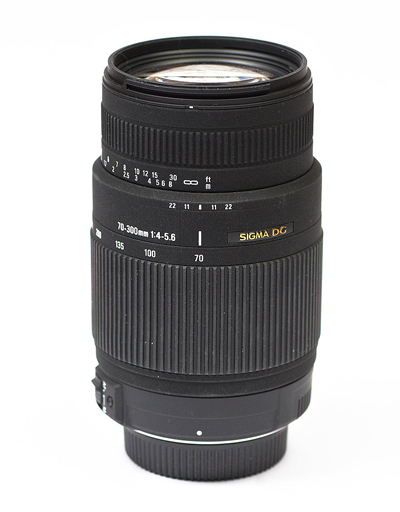 |  ePHOTOzine resident lens tester, Gary Wolstenholme casts his discerning eye over the Sigma 70-300mm. |
Sigma 70-300mm f/4-5.6 DG OS: Handling and features
The lens is quite lightweight and feels at home on full-frame as well as cropped sensor DSLRs. It is mostly constructed of plastic, which is typical for lenses of this price point. The plastics used are high in quality and the lens feel very well put together. The metal lens mount will stand up to many lens changes. A powder coated finish has been applied to the barrel of the lens and this looks very smart out of the box. From my own experience I know this coating is prone to showing marks under normal use, so it may not look so smart in time, depending on how you look after it.
Focusing is powered by a standard micro-motor, which makes a bit of noise during autofocusing. It is still be enough to be disturbing depending on what you are shooting. AF isn't overly fast, especially in low light. The lens tends to hunt in lower light conditions, especially at the longer end of the zoom. The focus ring rotates during AF and there is no way to disengage it. I find it catches my fingers as it moves back and forth.
The lens extends by around 2inches when zoomed in and focusing extends the lens barrel further. The front element does rotate during AF, which may pose issues for people wishing to use polarisers or graduated filters with the lens. The zoom action is smooth and offers just the right amount of resistance to make selecting the desired focal length easy, without risking zoom creep when the lens is pointed downwards.
Nikon's equivalent lens is the 70-300mm VR, which costs over £100 more, but includes a Silent Wave focusing motor and internal focusing. Canon users have the option of the 75-300mm MkIII USM, which has an Ultrasonic motor, but no image stabilisation for £230, or the 75-300mm IS USM, which adds Image Stabilisation into the mix, but costs £400. Sony and Pentax users may not find this lens a compelling substitute unless seeing the effect of Image Stabilisation in the viewfinder is important to them. This Sigma sits nicely in the range as a cheaper alternative, albeit sacrificing the faster silent focusing motor.
Sigma 70-300mm f/4-5.6 DG OS: Performance
For this review, the lens was tested on a 12Mp Nikon D700 using Imatest.
At 70mm this lens produces images of good resolution from the widest aperture right down to f/16, with the edges gradually improving as the lens is stopped down. The best quality images at 70mm are produced between f/8 and f/11.
By 135mm, there has been a slight drop in resolution, with the lens still producing good centre sharpness wide open. The best quality images are still produced between f/8 and f/11 with the sharpness across the frame being absolutely uniform at f/11.
Venture further into the zoom range and the clarity drops off noticeably. The lens is still capable of producing acceptable results for most wide open, but stopping down a couple of stops will improve the clarity of images. In use, I did notice a drop in contrast at 300mm, which will affect the apparent sharpness of images.
| Resolution at 70mm |
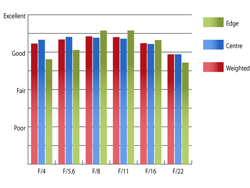 |
| Resolution at 135mm |
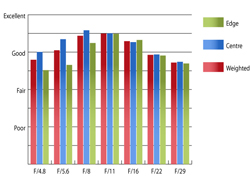 |
| Resolution at 300mm |
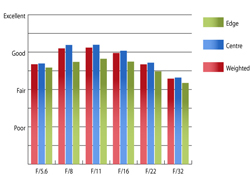 |
Chromatic aberrations are very well controlled at the shorter end of the zoom range and will not pose any problems. Beyond 135mm, things go a little pear-shaped though, with chromatic aberration increasing, but not to an overly disturbing level. Imatest recorded a CA area of 0.7 pixel-widths at f/5.6 and 300mm, which shouldn't cause too many issues for most.
| Chromatic Aberrations at 70mm |
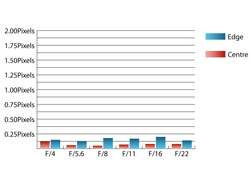 |
| Chromatic Aberrations at 135mm |
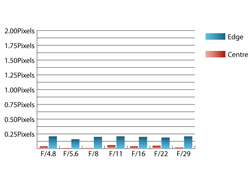 |
| Chromatic Aberrations at 300mm |
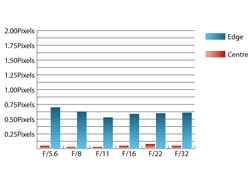 |
Light falloff in the corners at 70mm is reasonably well-controlled with the corners being 1.53 stops darker than the image centre at f/4. Stopping down to f/6.3 provides even illumination across the image area. At 200mm and f/5.6 the corners are 1.94 stops darker, which may pose a problem for some. Stopping down to f/8 provides even illumination across the frame.
 The Sheffield Car Park at 70mm. | 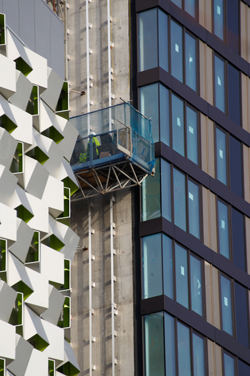 Zooming in to 300mm. |
Distortion is very well controlled at 70mm producing 0.07% pincushion distortion, which is an almost negligible amount. At 200mm the amount of pincushion distortion rises to 2.62%, which may be noticeable in some circumstances, but more often than not, will not cause any issues.
 | 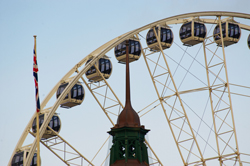 |
Strong light sources in the frame will cause a little flare, spreading from the light across the image centre. Typically this lens controls flare pretty well throughout the zoom range, with only feint green and amber ghosts appearing in extreme circumstances. Light sources just outside the frame cause few issues, with contrast being reduced a little in extreme circumstances. The supplied lens hood virtually eliminates this, so I would tend to leave it fitted at all times.
Sigma's Optical Stabilisation system helps greatly with being able to take images in low light conditions and at slower shutter speeds. I was able to take sharp hand-held shots most of the time at shutter speeds of 1/15sec at 70mm and 1/30sec at 300mm, which is pretty good performance and will help greatly to tame camera shake.
 | DxOMark provides objective, independent, RAW-based image quality performance data for lenses and digital cameras to help you select the best equipment to meet your photographic needs. Visit the DxOMark website for tests performed on the Sigma 70-300mm f/4-5.6 DG OS. |
Sigma 70-300mm f/4-5.6 DG OS: Verdict
Overall. the Sigma 70-300mm OS is a good value alternative to the camera manufacturer's own offerings, providing decent enough resolution at a lower price point than independent equivalents with low distortion and decent enough resistance to flare and ghosting.
Although the resolution tails off at the longer end of the lens, the clarity produced will still satisfy all but the most demanding photographers.
| FEATURES |  |
| HANDLING |  |
| PERFORMANCE |  |
| VALUE |  |
| OVERALL |  |
Sigma 70-300mm f/4-5.6 DG OS: Pros
 Good resolution at shorter focal lengths
Good resolution at shorter focal lengths Optical Stabiliser
Optical Stabiliser Low Distortion at 70mm
Low Distortion at 70mmSigma 70-300mm f/4-5.6 DG OS: Cons
 Rotating AF ring
Rotating AF ring Drop off in resolution and contrast at 300mm
Drop off in resolution and contrast at 300mm Slow focusing speed
Slow focusing speedSigma 70-300mm f/4-5.6 DG OS: Specification
| Price | £310 |
| Contact | www.sigma-imaging-uk.com |
| Filter size | 62mm |
| Format | Full frame/35mm/FX |
| Construction | 16 elements in 11 groups |
| Angle-of-view | 34.3° - 8.2° |
| 35mm equivalent focal length (on APS-C body) | 105-450mm (Nikon/Pentax/Sony), 112-480mm (Canon) |
| Internal focusing | No |
| Image stabilisation | Yes |
| Minimum focus | 150cm |
| Maximum aperture | f/4-5.6 |
| Minimum aperture | f/22-32 |
| Weight | 610g |
| Size | 126x76.5mm |
| In the box | Circular lens hood |
The Sigma 70-300mm f/4-5.6 DG OS lens costs £314.99 and is available in a variety of fits at Warehouse Express here:
Sigma 70-300mm f/4-5.6 DG OS
Add your message
Login required
Please login here or if you've not registered, you can register here. Registering is safe, quick and free.
Please login here or if you've not registered, you can register here. Registering is safe, quick and free.
photodo Stats
1102 lenses
428 MTF tests
74 in-depth photodo reviews
100+ users join each day
Help the lens community by reviewing or rating a lens today via our lens search
428 MTF tests
74 in-depth photodo reviews
100+ users join each day
Help the lens community by reviewing or rating a lens today via our lens search
Latest Lens Reviews
- Chinon 28mm f/2.8 Vintage Lens Review
- Canon EF 70-200mm f/4L IS II USM Lens Review
- Samyang AF 85mm f/1.4 EF Review
- Sigma 70mm f/2.8 DG Macro Art Review
- Samyang AF 24mm f/2.8 FE Review
- Meike 50mm f/1.7 Review
- Tamron 70-210mm f/4 Di VC USD Review
- Lensbaby Burnside 35mm f/2.8 Review
- Asahi Super Takumar 50mm f/1.4 Review
- Asahi Super-Multi-Coated Takumar 135mm f/3.5 Review
